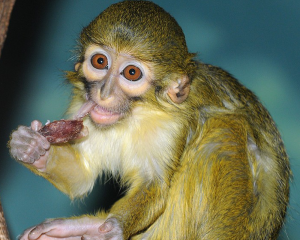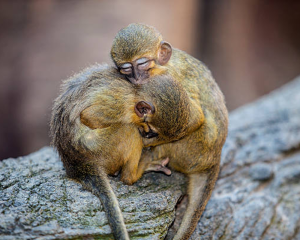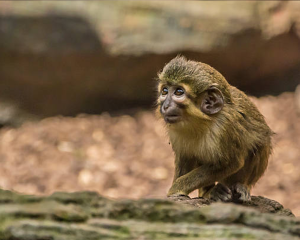
Talapoin monkeys are small primates belonging to the genus Miopithecus. They are the smallest members of the Old World monkey family, Cercopithecidae. There are two species of talapoin monkeys: the Angola talapoin (Miopithecus talapoin) and the Gabon’s talapoin (Miopithecus ogouensis), both of which are native to Central Africa.
General Characteristics
Talapoin monkeys are the smallest Old World monkeys, with adult males typically weighing between 1.3 to 1.9 kilograms (2.9 to 4.2 pounds) and females weighing around 0.8 to 1.4 kilograms (1.8 to 3.1 pounds).
They have a short, dense coat that is typically greenish-grey on the back and sides, with lighter, almost white fur on the underside.
Their faces are pinkish with distinctive dark markings around the eyes and muzzle, giving them a unique facial appearance.
They have a relatively long tail, which is not prehensile but helps with balance while moving through the trees.

Behavior
Talapoin monkeys are highly social animals that live in large groups, which can range from 60 to 100 individuals, although smaller groups of around 20 to 30 are more common.
They are diurnal, meaning they are active during the day and rest at night.
Talapoin monkeys are primarily arboreal, spending most of their time in the trees, but they are also known to forage on the ground.
They communicate using a variety of vocalizations, facial expressions, and body gestures to maintain group cohesion and convey social information.

Diet
Talapoin monkeys are omnivorous, with a diet consisting mainly of fruits, leaves, seeds, flowers, and insects. They also eat small vertebrates and eggs when available.
Their diet is quite varied and changes with the availability of food in their environment. During the dry season, when fruits are less abundant, they rely more on leaves and insects.

Conservation Status
Both species of talapoin monkeys are currently listed as “Least Concern” on the International Union for Conservation of Nature (IUCN) Red List. However, this status can vary regionally, and some populations may face localized threats.
Threats
The primary threats to talapoin monkeys include habitat loss due to deforestation, agricultural expansion, and human settlement. Hunting for bushmeat and the pet trade also poses significant risks in some areas.
Although they are currently not considered to be at high risk of extinction, continued habitat degradation and human encroachment could lead to future declines in their populations.

Interesting Facts
Smallest Old World Monkeys: Talapoin monkeys hold the distinction of being the smallest Old World monkeys, a feature that contributes to their agility and ability to navigate dense forest canopies.
Adaptation to Aquatic Habitats: Unlike many other primates, talapoin monkeys are frequently found near water and have adapted to living in swampy and riverine habitats. They are good swimmers and have been observed crossing rivers to find food or escape predators.
Predator Awareness: Talapoin monkeys have developed keen predator awareness, with distinct alarm calls for different types of threats. This helps alert other group members to the presence of potential predators such as eagles, snakes, and large carnivores.
Fission-Fusion Dynamics: While they typically live in large groups, talapoin monkeys may exhibit fission-fusion dynamics, where the group splits into smaller subgroups temporarily to forage or move through dense vegetation. This flexibility allows them to adapt to varying environmental conditions and resource availability.
Talapoin monkeys are fascinating primates with unique adaptations to their environments and social structures. Although not as widely known as some other primate species, they play important roles in their ecosystems and contribute to the biodiversity of Central African forests.




